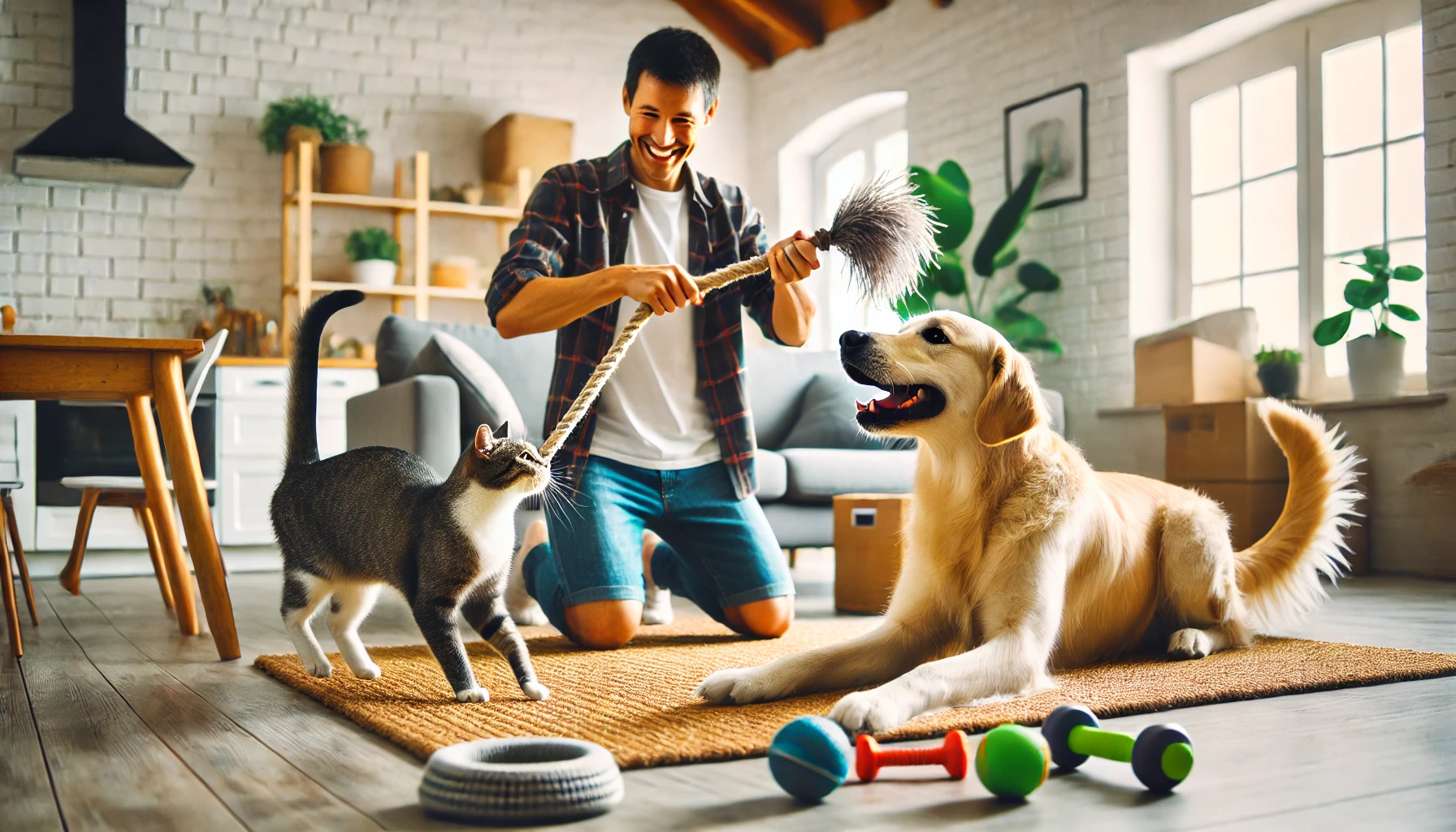Playtime is more than just a fun activity for pets—it’s an essential part of building trust, fostering communication, and strengthening the bond between you and your furry companion. Pets thrive on physical and mental stimulation, and engaging in interactive play provides the perfect opportunity to create a deeper connection. Here’s how to use play as a tool to enhance your relationship with your pet.
Why Play is Important for Bonding
Play is a natural behavior for pets, and it satisfies their instincts while promoting physical health and emotional well-being.
Benefits of Play for Pets
- Physical Exercise: Helps pets stay fit and maintain a healthy weight.
- Mental Stimulation: Engages their problem-solving abilities and prevents boredom.
- Stress Relief: Reduces anxiety and provides an outlet for pent-up energy.
- Behavioral Improvement: Encourages positive behaviors by channeling energy constructively.
How Play Strengthens Bonds
- Trust Building: Pets learn to trust you as a source of fun and comfort.
- Communication: Interactive play helps you understand your pet’s likes, dislikes, and body language.
- Positive Reinforcement: Rewarding good behavior during playtime reinforces your pet’s confidence.
Understanding Your Pet’s Play Style
Every pet has a unique personality and play preferences. Understanding these can make playtime more enjoyable for both of you.
Dogs
- Fetch Enthusiasts: Dogs that love chasing objects will enjoy balls, frisbees, and throw sticks.
- Tug-of-War Players: Strong, energetic dogs often prefer tug toys.
- Puzzle Solvers: Intelligent breeds thrive on toys that challenge their minds, like treat-dispensing puzzles.
Cats
- Hunters: Cats with strong predatory instincts enjoy feather wands, laser pointers, and moving toys.
- Climbers: Active cats may prefer scratching posts, tunnels, or climbing trees.
- Cuddlers: Some cats are more inclined toward gentle play with soft toys.
Setting Up Playtime
Creating the right environment for play is essential for a positive experience.
Choose the Right Space
- Indoors: Clear an area free of breakable items to prevent accidents.
- Outdoors: Use secure spaces like fenced yards or parks to ensure your pet’s safety.
Use Safe and Engaging Toys
- Durable Materials: Choose toys that are strong enough to withstand your pet’s play style.
- Interactive Toys: Treat-dispensing puzzles or toys with unpredictable movements keep pets engaged.
- Rotate Toys: To prevent boredom, swap out toys regularly to keep things fresh.
Set a Routine
- Consistency: Schedule regular play sessions at the same time each day.
- Duration: Keep sessions between 15 to 30 minutes, depending on your pet’s energy level.
Interactive Play Ideas
Interactive play strengthens the bond by involving both you and your pet.
For Dogs
- Fetch: A classic game that lets your dog burn energy while reinforcing recall commands.
- Tug-of-War: Builds your dog’s strength and encourages controlled play.
- Hide-and-Seek: Hide treats or toys around the house and let your dog find them using their sense of smell.
For Cats
- Feather Wands: Mimic the movement of prey to tap into your cat’s hunting instincts.
- Laser Pointers: Provide quick, unpredictable movements that keep cats engaged.
- Interactive Playgrounds: Use tunnels, climbing trees, and scratching posts to create a stimulating environment.
Incorporating Training Into Play
Playtime is an excellent opportunity to teach your pet new skills or reinforce positive behaviors.
- Obedience Commands: Combine play with commands like “sit,” “stay,” or “fetch” to make learning fun.
- Reward-Based Games: Use treats as incentives during games to encourage cooperation.
- Agility Training: Set up simple obstacle courses to improve coordination and focus.
Recognizing and Respecting Boundaries
Not all pets are equally enthusiastic about play. Pay attention to your pet’s signals to ensure they’re enjoying the activity.
Signs Your Pet is Having Fun
- Dogs: Wagging tails, playful barks, and energetic movements.
- Cats: Focused eyes, purring, and chasing or swatting at toys.
Signs of Discomfort
- Dogs: Avoidance, yawning, or whining may indicate overstimulation or fatigue.
- Cats: Hissing, swatting, or retreating to a hiding spot are signs they need a break.
If your pet seems uninterested, try different toys or adjust the intensity of the activity.
Strengthening the Bond Through Positive Reinforcement
Positive reinforcement during playtime helps build trust and confidence in your pet.
- Verbal Praise: Use an upbeat tone to encourage and reward good behavior.
- Treats: Offer small treats during or after play as a reward for engagement.
- Affection: End play sessions with cuddles or gentle petting to reinforce the positive experience.
Adapting Play for Pets with Special Needs
Special needs pets can enjoy playtime with a few adjustments.
- Senior Pets: Choose gentler activities like slow-paced fetch or plush toys.
- Mobility Challenges: Use toys that encourage minimal movement, such as treat puzzles or interactive feeders.
- Blind or Deaf Pets: Focus on toys with strong scents, textures, or vibrations to engage their other senses.
Maintaining a Healthy Balance
While play is essential, it’s important to balance it with other aspects of your pet’s care.
- Exercise: Combine play with daily walks or other physical activities to keep your pet fit.
- Mental Stimulation: Use training, puzzle toys, or socialization to keep your pet mentally sharp.
- Rest: Allow your pet time to relax and recharge after play sessions.
Conclusion
Playtime is more than a physical activity—it’s a chance to connect, communicate, and deepen your bond with your pet. By understanding their play style, providing the right environment, and using positive reinforcement, you can create memorable experiences that enhance your relationship. With consistent effort and creativity, play can become a cornerstone of your pet’s happiness and well-being.

